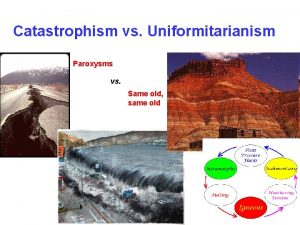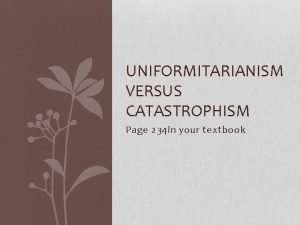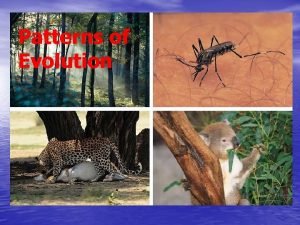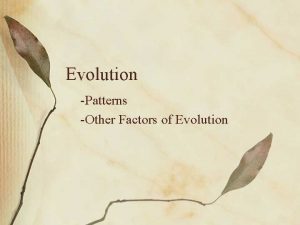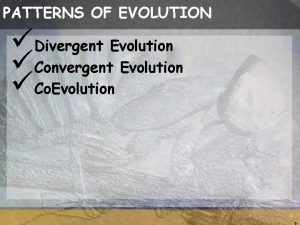Patterns of Evolution 92013 Catastrophism theory that the









- Slides: 9

Patterns of Evolution 9/20/13

Catastrophism � theory that the Earth has been affected in the past by sudden, short-lived, violent events, possibly worldwide in scope. � Dinosaurs becoming extinct because of a meteorite is a good example.

Gradualism � theory which holds that major change is the cumulative product of slow but continuous processes. � Evolution of mankind! Very slow and gradual evolutionary changes from primates to modern humans.

Punctuated equilibrium � most species will exhibit little evolutionary change and then a huge event or a few occurs to change things. Change in spurts! � Mutations are a good example. � Demise of dinosaurs and age of mammals.

Convergent Evolution � independent evolution of similar features in species of different lineages. � The wing is a classic example of convergent evolution in action. Flying insects, birds, and bats have all evolved the capacity of flight independently. They have "converged" on this useful trait.

Quick Check � Dinosaur species dominated Earth for over 100 million years. During this time, most mammals were small mouse-sized nocturnal organisms. Following the mass extinction of the dinosaurs, the small mammals rapidly diversified to fill available habitats and niches. What pattern of evolution best explains the diversification of mammals? A. Catastrophism B. Convergent evolution C. Gradualism D. Punctuated Equilibrium

Forms of natural selection Disruptive - selection against phenotypes (physical appearance) in the middle and favors both extremes. Stabilizing – selection against extreme phenotypes (physical appearance) and favors the average. Directional – favors one extreme phenotype (physical appearance) over all others, causing a directional shift to one side or another.

Types of cladograms

Cladogram Analysis � Part I – Determine the traits that distinguish each group. � Part II – Create your own. Follow directions on your worksheet. � The worksheet will be collected at the end of class.
